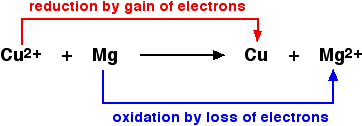Learn important concepts of the chapter.
Rules for assigning oxidation number.
Following are the general rules for assigning oxidation number:
1. The oxidation number of an element in its free states is zero.
For example : Al(s) O.n.= 0.
2. The oxidation number of a monatomic ion is the same as the charge on the ion, for example: Na+1:O.N=1
3. H shows +1 oxidation with nonmetals and -1 oxidation number with metals.
4. O always shows -2 oxidation number and exceptional in case of peroxide where it shows -1 oxidation state.
2
Identifying oxidising and reducing agent according to electron transfer concept

In this reaction Cu+2 gain 2 electron hence it is oxidizing agent and Mg lose 2 electron so it behaves as a reducing agent.
3
Comproportionation reactions
Comproportionation reaction is a chemical reaction where two reactants, each containing the same element but with a different oxidation number, will form a product in which the elements involved reach the same oxidation number
Ex: In lead batteries, the spontaneous reaction is:
Pb(s)+PbO2(s)+2H2SO4(aq)→2PbSO4(s)+2H2O(l)
Potassium permangante contains manganese with oxidation number of +7 and reacts with a manganese compound having oxidation number +2 to yield manganese dioxide with oxidation number +4, potassium hydroxide and water4
Types of redox reaction
1.Combination Reaction : A reaction in which two atoms or molecules combine to form third molecule is called combination reaction.
2.Decomposition : A reaction in which a molecule breaks down into two or more molecules.
3.Displacement : A reaction in which an atom or ion in a compound is replaced by an atom or ion of some other element.
4.Disproportionation Reaction : Reaction in which the same species is simultaneously oxidized as well as reduced .
5

The oxidation number method, keeps track of electrons gained when a substance is reduced and the electrons lost when a substance is oxidized. 6
Balance redox half-reaction or ion-electron method
1. Divide the equation in 2 half-reactions.
2. Balance atoms other than H and O.
3. Balance O by adding H2O to the side that needed oxygen.
4. Balance H by adding H+ ion to the side that needed H.
5. Balance the net charge by adding electrons.
6.Make electron gain equal to electron loss and add half cell reactions.
7.Cancel any thing that is same on both the sides.


